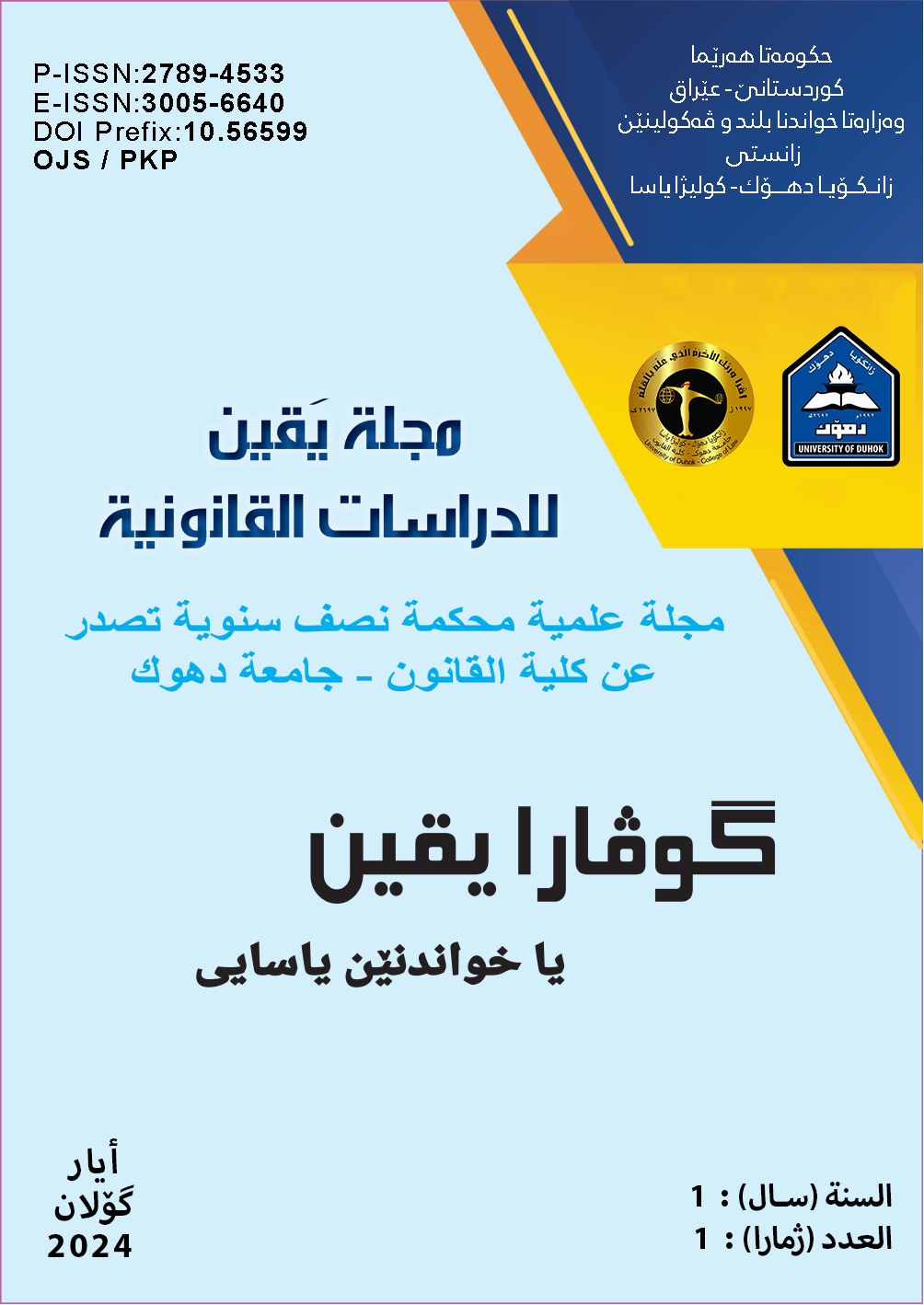الملخص
يتناول هذا البحث الاشكالية في ايجاد الية قانونية لتكييف المخدرات الرقمية، وبالتالي بيان المسؤولية الجنائية وفق المنظومة الجنائية العراقية الحالية، هذا من جانب، ومن جانب اخر، حاولنا حث المشرعين العراقي الاتحادي والكردستاني الاقليمي (اقليم كردستان العراق) على القيام بمزامنة تداعيات الجرائم الالكترونية المستحدثة واستشراف العواقب المستقبلية المترتبة من جراء مثل هذه الجرائم، انطلاقا من مبدأ حماية أمن واستقرار وسلامة المجتمع عن طريق سن قوانين عصرية لمواجهة الجرائم الالكترونية، وعدم افلات مرتكبيها من العقاب.
لذا، من أجل الاحاطة بموضوع البحث، قمنا بتقسيمه الى مبحثين؛ في المبحث الاول، قمنا بدراسة ماهية المخدرات الرقمية، من خلال تعريف والية عمل هذه المخدرات، بالإضافة الى دراسة التحديات العلمية والقانونية لمواجهة المخدرات الرقمية، بينما في المبحث الثاني قمنا بدراسة الالية القانونية لتكييف المخدرات الرقمية، من خلال مقاربتين، في اولهما حاولنا تكييف المخدرات الرقمية كمخدرات تقليدية، بينما في المقاربة الثانية حاولنا تكييف هذه المخدرات كجريمة احتيال الالكتروني. وفي هذه الخطوة الاستباقية، وبالاستناد الى مبادئ العدالة التنبؤية، حاولنا وضع استراتيجية جنائية مساعدة من اجل الوصول تشريعيا لحل اشكالية تكييف المخدرات الرقمية من خلال هاتين المقاربتين.
المراجع
اولا: المصادر باللغة العربية
الكتب
المناعسة، اسامة احمد والزغبي ، جلال محمد، جرائم تقنية نظم المعلومات الإلكترونية : دراسة مقارنة وفقا لقانون جرائم أنظمة المعلومات رقم 30 لسنة 2010 و الاتفاقية العربية لمكافحة جرائم تقنية المعلومات لعام 2012 (ط 2، مزيدة ومنقحة). عمان، الاردن: دار الثقافة للنشر والتوزيع، 2014.
محمد بن يونس، عمر، المخدرات والمؤثرات العقلية عبر الإنترنت، الإسكندرية : دار الفكر الجامعى، 2004. تم استرجاعه في 03/11/2023 على الرابط https://library.dji.ae/libero/WebopacOpenURL.cls?ACTION=DISPLAY&sid=LIBERO:DJI&RSN=770#CatInfo770
المجلات العلمية
الاسدي، لينا محمد، القصور التشريعي في مواجهة المخدرات الرقمية (دراسة في ظل قانون المخدرات والمؤثرات العقلية العراقي رقم 50 لسنة 2017 النافذ)، مجلة كلية القانون، جامعة النهرين 21(3)، 2018.
الرفاعي، أياد فتيح علي وزينة، نسرين جورج عيسى، المخدرات الرقمية: انواعها والإدمان على مسببها، المركز العربي للبحوث القانونية والقضائية، 2021.
السعدي، عائشة عبدالله والنور، محمد سليمان، المخدرات الرقمية وآثارها على مقصد العقل: دراسة مقاصدية، بحث منشور بمجلة البحوث العلمية والدراسات الإسلامية 11(4), 197-238 ، 2019 تم استرجاعه في 03/11/2023 على الرابط https://www.asjp.cerist.dz/en/article/112833
الهياس، خولة موسى عبد الله، استغلال وسائل تقنية المعلومات في ارتكاب جرائم المخدرات و خاصة الرقمية في ضوء قانون مكافحة جرائم تقنية المعلومات الإماراتي. مجلة العلوم الاقتصادية و الإدارية و القانونية،2(9)، 168-181، 2018.
بوخدونى، صبيحة و بن عاشور، الزهرة، الإدمان على المخدرات الرقمية وعلاقتها بالانحراف والجريمة لدى الشباب. مجلة أنسنة للبحوث والدراسات 11(01), 115-130، 2020. تم استرجاعه في 03/11/2023 على الرابط https://www.asjp.cerist.dz/en/downArticle/320/11/2/124894
حنة، عبد القادر وخطوط، رمضان والهاشمي، حنة، دور الإرشاد النفسي في علاج الإدمان على المخدرات الرقمية. مجلة سوسيولوجيا للدراسات والبحوث الاجتماعية، العدد الخاص (أيلول 2020)، 193-211، 2020.
فهيل عبدالباسط عبدالكريم، دور التكنولوجيا الرقمية في تحقيق العدالة الجنائية: الفرص والتحديات. مجلة جامعة دهوك, 25(2), 908-924، 2023. تم استرجاعه في 03/11/2023 على الرابط https://doi.org/10.26682/hjuod.2022.25.2.47.
فقي خليل، كارزان، آثار وأسباب المخدرات الرقمية ومعالجتها من منظور إسلامي، بحث منشور بمجلة قه لاي زانست العلمية 3 (2), 204-224، 2017. تم استرجاعه في 03/11/2023 على الرابط https://doi.org/10.25212/lfu.qzj.2.3.10
الندوات العلمية
أبو دوح، خالد كاظم، الندوة العلمية حول المخدرات الرقمية وتأثيرها على الشباب العربي (7-9 / 5 / 1437 هـ الموافق 16-18 / 2 / 2016 م)، 2016. جامعة نايف العربية للعلوم الأمنية.
ثانيا: التشريعات باللغة العربية
الدستور العراقي النافذ لسنة 2005.
قانون (العراقي) المخدرات والمؤثرات العقلية رقم 50 لسنة 2017. (الوقائع العراقية، الجريدة الرسمية العراقية، قانون المخدرات والمؤثرات العقلية رقم 50 لسنة 2017، العدد 4446، 2017. تم استرجاعه في 03/11/2023 على الرابط https://www.moj.gov.iq/upload/pdf/4446.pdf).
قانون العقوبات العراقي رقم 111 لعام 1969.
قانون تصديق الاتفاقية العربية لمكافحة جرائم تقنية المعلومات رقم 31 لسنة 2013. (الوقائع العراقية، الجريدة الرسمية العراقية، قانون تصديق الاتفاقية العربية لمكافحة جرائم تقنية المعلومات رقم 31 لسنة 2013، العدد 4292 ، 2013. تم استرجاعه في 03/11/2023 على الرابط https://www.moj.gov.iq/uploaded/4292.pdf).
قانون مكافحة المخدرات والمؤثرات العقلية رقم 1 لسنة 2020 في إقليم كردستان العراق. (وقائع كوردستان، الجريدة الرسمية لاقليم كردستان- تصدر من قبل وزارة العدل، قانون مكافحة المخدرات والمؤثرات العقلية في اقليم كردستان العراق رقم 1 لسنة 2020 ، العدد 257 ، 2020. (متن مواد القانون باللغة العربية يبدآ من الصفحة 44) تم استرجاعه في 03/11/2023 على الرابط https://govkrd.b-cdn.net/Ministries/Ministry of Justice/Kurdish/بڵاوکراوەکان/وەقائعی کوردستان/251-300/وەقائعی کوردستان.257.pdf ).
ثالثا: المراجع باللغة الانجليزية
Aldridge, Judith , Askew Rebecca. 2017. “Delivery dilemmas: How drug cryptomarket users identify and seek to reduce their risk of detection by law enforcement”. International Journal of Drug Policy 41(March):101–109. Accessed July 4, 2023. Accessed July 5, 2023, https://doi.org/10.1016/j.drugpo.2016.10.010.
Barratt, Monica Jane. 2011. “Discussing illicit drugs in public internet forums: visibility, stigma, and pseudonymity”. In: Kjeldskov J., Paay J., editors. C&T ’11 Proceedings of the Fifth International Conference on Communities and Technologies, Brisbane, Australia. New York, NY: ACM; 159–168.
Denton B., O’Malley P. 1999. “Gender, trust and business: women drug dealers in the illicit economy”. The British Journal of Criminology; 39:513–530.
Galenianos, Manolis, Rosalie Liccardo Pacula, Pacula Nicola. 2012. “A search-theoretic model of the retail market for illicit drugs”. Review of Economic Studies. 79:1239–1269.
Jacques Scott, Richard Rosenfeld, Richard Wright, Frank van Gemert. 2016. “Effects of prohibition and decriminalization on drug market conflict”. Criminology Public Policy; 15: 843–875.
Knezevic, Marinela Z., Ivana C Bivolarevic, Tanja S Peric, Slobodan M Jankovic. 2011. “Using Facebook to increase spontaneous reporting of adverse drug reactions”. Drug safety, 34(4):351–352. Accessed July 6, 2023. https://doi.org/10.2165/11590110-000000000-00000
Müller Christian P., Gunter Schumann. 2011. “Drugs as instruments: a new framework for non-addictive psychoactive drug use”. Behavioral and Brain Sciences, 34(6), 293-310. Accessed July 6, 2023. doi:10.1017/S0140525X11000057
Nick Phillips, 2021, Digital Cities, Digital Crimes: Mapping Spanish Detective Fiction. Hispania, 104(4).
Oster G. (1973). Auditory beats in the brain. Scientific American, 229(4), 94–102. https://doi.org/10.1038/scientificamerican1073-94
Van Buskirk, J., Bruno, R., Dobbins, T., Breen, C., Burns, L., Naicker, S., & Roxburgh, A. 2017, The recovery of online drug markets following law enforcement and other disruptions. Drug and alcohol dependence, 173, 159–162. https://doi.org/10.1016/j.drugalcdep.2017.01.004
رابعا: التشريعات باللغة الانجليزية
United Nations Office on Drugs and Crime report, Executive Summary Policy Implication, World Drug Report, 2021. https://www.unodc.org/res/wdr2021/field/WDR21_Booklet_1.pdf
Single Convention on Narcotic Drugs, 1961. As amended by the 1972 Protocol amending the Single Convention on Narcotic Drugs, 1961. https://www.unodc.org/pdf/convention_1961_en.pdf
Yaqeen Journal for legal studies





